News
Contact
- User Program Manager
- Heather Brown
Important information for CINT users
We extend our best wishes to your families, friends, and colleagues, as the world confronts the unprecedented challenges of the COVID-19 pandemic.
CINT leadership is working with the management teams of both host laboratories to develop phased reopening plans. At this time, the Core Facility is planning to reopen for onsite users starting this month. LANL has transitioned to limited-operations, allowing the Gateway Facility to begin resuming onsite operations over the coming weeks. We are optimistic that the Gateway will be in a similar position to accommodate local users onsite in the relatively near future. We recognize that it will continue to be difficult (and overly restrictive) to synchronize the levels of onsite activity at the Core and Gateway. In this light, we will strive to do everything we can to assist our colleagues and friends across both institutions and ensure the long-term success of our vibrant user program.
In Phase I, we will welcome New Mexico (NM) users back to the Core facility in Albuquerque as of Monday 6/8/2020. Our onsite target for Phase I will be a 50% occupancy footprint; we are far below this target right now. The safety and health of the CINT community and their families is our top priority. All visits must be arranged in advance with the CINT user support scientist to ensure appropriate occupancy of each lab space before coming on-site.
Hosting users from out-of-state and international institutions will occur in subsequent phases. We will handle out-of-state visitors on a case-by-case basis, so please ensure you contact the CINT scientist you are working with prior to making travel plans. We are still developing a plan to welcome back users from international institutions.
Computational and theoretical capabilities continue to be available at both the Core and Gateway facilities.
If you have questions about our phased reopening plans, or if you have a user proposal related to COVID-19 research, please contact the CINT Program Management Team.
Core Facility (Albuquerque):
- Jeff Nelson, CINT Director | jsnelso@sandia.gov
- Brian Swartzentruber | bsswart@sandia.gov
- Ryan Wixom | rrwixom@sandia.gov
- Heather Brown | hdbrown@sandia.gov
Gateway Facility (Los Alamos):
- Adam Rondinone, CINT Co-Director | rondinoneaj@lanl.gov
- Jim Werner | jwerner@lanl.gov
- Dmitry Yarotski | dzmitry@lanl.gov
- Beth Stelle | stelle@lanl.gov
New Capabilities
Quantum Diamond Magnetometry Microscope. Find out more.
Scientist Spotlight
New CINT Co-Director: Adam Rondinone. Find out more.
CINT in the News
Machine Learning Speeds Molecular Motion Modeling
BES Science Highlight (07/17/20) CINT scientists and users have used a machine learning technique called transfer learning to create a model of molecular motion that is as accurate as quantum-mechanical calculations but much faster. This approach can describe a range of chemical processes and dynamics of functional organic materials.
CINT scientists and users have used a machine learning technique called transfer learning to create a model of molecular motion that is as accurate as quantum-mechanical calculations but much faster. This approach can describe a range of chemical processes and dynamics of functional organic materials.
Breakthrough In Developing Multi-Watt Terahertz Lasers
Eurasia Review (06/16/20) Reserachers from Lehigh University and CINT have reported another terahertz technology breakthrough: they have developed a new phase-locking technique for plasmonic lasers and, through its use, achieved a record-high power output for terahertz lasers. Their laser produced the highest radiative efficiency for any single-wavelength semiconductor quantum cascade laser.
Reserachers from Lehigh University and CINT have reported another terahertz technology breakthrough: they have developed a new phase-locking technique for plasmonic lasers and, through its use, achieved a record-high power output for terahertz lasers. Their laser produced the highest radiative efficiency for any single-wavelength semiconductor quantum cascade laser.
Organic Spacers Improve LED Performance
Brookhaven News Release (05/14/20) By sandwiching a 2D light-emitting layer in between carbon-based compounds with atoms arranged in a circular instead of linear shape, scientists significantly improved device efficiency and brightness. This work was done at three NSRCs – CINT, Center for Functional Nanomaterials, Center for Nanoscale Materials – as well as the Advanced Photon Source.
By sandwiching a 2D light-emitting layer in between carbon-based compounds with atoms arranged in a circular instead of linear shape, scientists significantly improved device efficiency and brightness. This work was done at three NSRCs – CINT, Center for Functional Nanomaterials, Center for Nanoscale Materials – as well as the Advanced Photon Source.
Self-powered X-ray detector to revolutionize imaging for medicine, security and research
C&EN (04/10/20)Space Daily (04/14/20)
Physics World (04/16/20)
LANL News Release (04/20/20)
 A new X-ray detector prototype is on the brink of revolutionizing medical imaging, with dramatic reduction in radiation exposure and the associated health risks, while also boosting resolution in security scanners and research applications. The detector replaces silicon-based technology with a structure built around a thin film of the mineral perovskite, resulting in a hundred times more sensitivity than conventional silicon-based detectors.
A new X-ray detector prototype is on the brink of revolutionizing medical imaging, with dramatic reduction in radiation exposure and the associated health risks, while also boosting resolution in security scanners and research applications. The detector replaces silicon-based technology with a structure built around a thin film of the mineral perovskite, resulting in a hundred times more sensitivity than conventional silicon-based detectors.
CINT student receives Erasmus Mundus Scholarship
Colorado College Newsroom (03/26/20)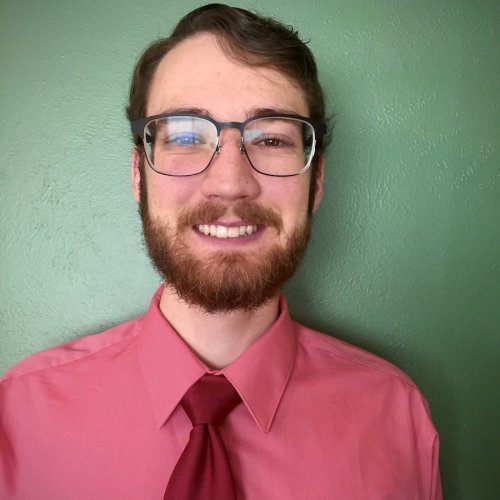 CINT student Kenneth Crossley has been awarded a highly competitive Erasmus Mundus scholarship for a two-year joint science master's degree. He will take quantum mechanics, chemistry, and materials science courses focused on renewable energy storage and conversion at the University of Paris-Saclay and later at the University of Genoa. At CINT, Kenneth evaluates nanostructures for their ability to reduce the stress induced by inserting lithium into next-generation electrodes for lithium ion batteries.
CINT student Kenneth Crossley has been awarded a highly competitive Erasmus Mundus scholarship for a two-year joint science master's degree. He will take quantum mechanics, chemistry, and materials science courses focused on renewable energy storage and conversion at the University of Paris-Saclay and later at the University of Genoa. At CINT, Kenneth evaluates nanostructures for their ability to reduce the stress induced by inserting lithium into next-generation electrodes for lithium ion batteries.
New Metasurface Helps Make the Switch to Terahertz Frequencies
BES Science Highlight (03/23/20) Researchers are finding promising new applications for terahertz radiation, which is in the band of frequencies higher than microwaves but lower than infra-red light. Terahertz radiation could lead to new capabilities in imaging, wireless communications, and other areas. In this latest research, CINT staff and users have developed a metasurface which uses light to change electrical conductivity between a highly resistive "off state and a highly conductive "on" state in less than a picosecond.
Researchers are finding promising new applications for terahertz radiation, which is in the band of frequencies higher than microwaves but lower than infra-red light. Terahertz radiation could lead to new capabilities in imaging, wireless communications, and other areas. In this latest research, CINT staff and users have developed a metasurface which uses light to change electrical conductivity between a highly resistive "off state and a highly conductive "on" state in less than a picosecond.
New Materials Test Overcomes Thermal Limits
Machine Design (03/23/20) CINT staff and users from the University of Illinois at Urbana-Champaign have devised a new way to test microscopic sized samples of aeronautical materials at ultra-high temperatures. This lets scientists evaluate materials much more quickly and inexpensively than with traditional testing.
CINT staff and users from the University of Illinois at Urbana-Champaign have devised a new way to test microscopic sized samples of aeronautical materials at ultra-high temperatures. This lets scientists evaluate materials much more quickly and inexpensively than with traditional testing.
Flat-panel technology could transform antennas, wireless and cell phone communications
LANL News Release (03/20/20) Researchers and users at CINT are reinventing the mirror, at least for microwaves, potentially replacing the familiar 3D dishes and microwave horns we see on rooftops and cell towers with flat panels that are compact, versatile, and better adapted for modern communication technologies. The electronically controlled 2D metasurface promises improved microwave communications, beam steering without moving pieces, and one-way microwave mirrors.
Researchers and users at CINT are reinventing the mirror, at least for microwaves, potentially replacing the familiar 3D dishes and microwave horns we see on rooftops and cell towers with flat panels that are compact, versatile, and better adapted for modern communication technologies. The electronically controlled 2D metasurface promises improved microwave communications, beam steering without moving pieces, and one-way microwave mirrors.
Improved Catalyst Branches Out and Out-Performs
BES Science Highlight (02/04/20) Branched nanoparticles are one of the most promising catalysts because their branch sizes and surfaces can be tuned to enable both high catalytic activity and stability. CINT scientists and collaborators have achieved both of these critical features by creating branched nanoparticles from the metal ruthenium. This research could help improve how well ruthenium performs in hydrogen fuel cells.
Branched nanoparticles are one of the most promising catalysts because their branch sizes and surfaces can be tuned to enable both high catalytic activity and stability. CINT scientists and collaborators have achieved both of these critical features by creating branched nanoparticles from the metal ruthenium. This research could help improve how well ruthenium performs in hydrogen fuel cells.
No Strain, No Gain! Breakthrough in 2D Material that Produces Single Photons
BES Science Highlight (02/04/20)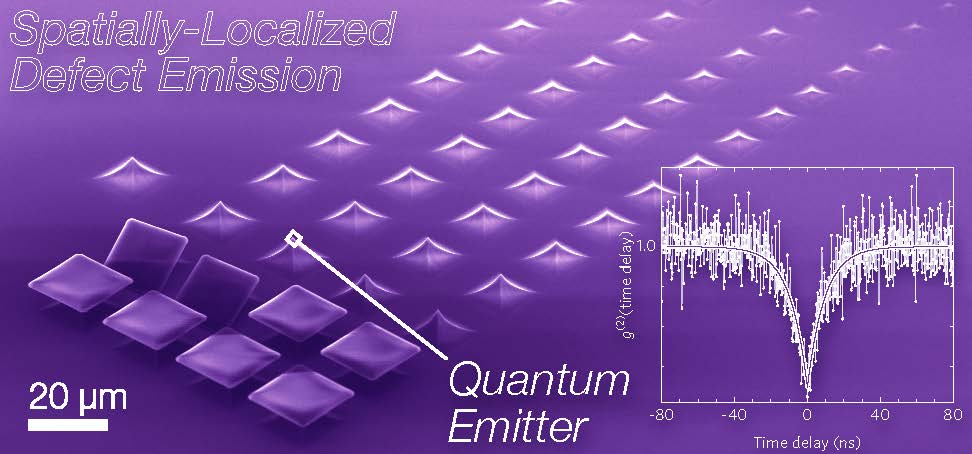 CINT scientists and collaborators have discovered a new method for achieving single photon emission by exploiting strain in 2D materials. The team synthesized a tungsten/selenium thin-film through chemical vapor deposition then transferred it to an array of ultra-sharp silicon dioxide tips. This creates spatially localized and well-separated photon emission sites in the thin-film.
CINT scientists and collaborators have discovered a new method for achieving single photon emission by exploiting strain in 2D materials. The team synthesized a tungsten/selenium thin-film through chemical vapor deposition then transferred it to an array of ultra-sharp silicon dioxide tips. This creates spatially localized and well-separated photon emission sites in the thin-film.
C. Barry Carter named Honorary RMS Fellow
RMS News Release (01/31/20) CINT distinguished affiliate scientist C. Barry Carter is being appointed Honorary Fellow of the Royal Microscopy Society (RMS) in recognition of his outstanding contributions to microscopy, in both science and education. Barry has had a lasting impact in materials science, especially in advancing understanding of the role and nature of defects in metals, semiconductors and ceramics.
CINT distinguished affiliate scientist C. Barry Carter is being appointed Honorary Fellow of the Royal Microscopy Society (RMS) in recognition of his outstanding contributions to microscopy, in both science and education. Barry has had a lasting impact in materials science, especially in advancing understanding of the role and nature of defects in metals, semiconductors and ceramics.
Jennifer Hollingsworth named AAAS Fellow
LANL News Release (11/26/19) CINT scientist Jennifer Hollingsworth is being honored as a Fellow in the American Association for the Advancement of Science (AAAS) for her work in materials chemistry. She is being honored specifically for her discovery and development of non-blinking giant quantum dots, spanning pioneering contributions to materials chemistry, photophysics of excited-state processes in nanomaterials and applications in optoelectronics.
CINT scientist Jennifer Hollingsworth is being honored as a Fellow in the American Association for the Advancement of Science (AAAS) for her work in materials chemistry. She is being honored specifically for her discovery and development of non-blinking giant quantum dots, spanning pioneering contributions to materials chemistry, photophysics of excited-state processes in nanomaterials and applications in optoelectronics.
Popsicles or nanomaterials?
LANL Facebook (10/31/19) These tiny zinc oxide rods were created in a water bath and are seen up close through a scanning electron microscope. The rods, which look like miniature popsicles, came about by accident: the researchers were aiming for T-shaped nanostructures but due to a lack of sodium citrate during synthesis, they instead made popsicle-shaped structures!
These tiny zinc oxide rods were created in a water bath and are seen up close through a scanning electron microscope. The rods, which look like miniature popsicles, came about by accident: the researchers were aiming for T-shaped nanostructures but due to a lack of sodium citrate during synthesis, they instead made popsicle-shaped structures!
Engineering success by predicting failure
Sandia Labs News Release (10/16/19) CINT scientist Brad Boyce, working with colleagues at Sandia National Laboratories, organized several challenges for researchers working to improve predictions for fractures in ductile metals. The third Sandia Fracture Challenge presented this challenge: Given the same basic information about the shape, composition, and loading of a metal part, could they predict how it would eventually fracture?
CINT scientist Brad Boyce, working with colleagues at Sandia National Laboratories, organized several challenges for researchers working to improve predictions for fractures in ductile metals. The third Sandia Fracture Challenge presented this challenge: Given the same basic information about the shape, composition, and loading of a metal part, could they predict how it would eventually fracture?
Creating and trapping trions at room temperature
UMD CMNS News & Events (10/16/19) A UMD-led team, in collaboration with CINT scientists, chemically engineered carbon nanotubes to synthesize and trap trions—quasi-particles potentially useful in bioimaging, chemical sensing and quantum computing. The research makes it possible to manipulate trions and study their fundamental properties.
A UMD-led team, in collaboration with CINT scientists, chemically engineered carbon nanotubes to synthesize and trap trions—quasi-particles potentially useful in bioimaging, chemical sensing and quantum computing. The research makes it possible to manipulate trions and study their fundamental properties.
High-harmonic generation in an ENZ material
Phys.org (08/15/19) New research published in Nature Physics by CINT staff and collaborators investigates high-harmonic generation arising from a low-loss, indium-doped cadmium oxide thin film, which was attained by leveraging the material’s epsilon-near-zero (ENZ) effect. Under the right conditions, the optical fields inside ENZ thin films are significantly enhanced. These films are of growing interest to researchers as they could allow the observation of some of the fastest events in nature in an easier, less expensive, and possibly more detailed way.
New research published in Nature Physics by CINT staff and collaborators investigates high-harmonic generation arising from a low-loss, indium-doped cadmium oxide thin film, which was attained by leveraging the material’s epsilon-near-zero (ENZ) effect. Under the right conditions, the optical fields inside ENZ thin films are significantly enhanced. These films are of growing interest to researchers as they could allow the observation of some of the fastest events in nature in an easier, less expensive, and possibly more detailed way.
CINT user wins Presidential Early Career Award
Sandia Labs News Release (08/01/19) CINT user Salvatore Campione received the Presidential Early Career Award for Scientists and Engineers (PECASE) for 2019. Salvatore was honored “For pioneering work in metamaterial and nanophotonic design, capability development in accurately predicting electromagnetic-pulse consequences on the U.S. power grid, and for excellence in engaging with the external scientific community and mentoring junior staff.”
CINT user Salvatore Campione received the Presidential Early Career Award for Scientists and Engineers (PECASE) for 2019. Salvatore was honored “For pioneering work in metamaterial and nanophotonic design, capability development in accurately predicting electromagnetic-pulse consequences on the U.S. power grid, and for excellence in engaging with the external scientific community and mentoring junior staff.”
CINT research receives OEA Best Paper Award
Opto-Electronic Journals (07/24/19) CINT scientists, users, and colleagues won one of Opto-Electronic Advances 2018-2019 Best Paper Awards for their paper “Nonlinear frequency conversion in optical nanoantennas and metasurfaces: Materials evolution and fabrication” (vol. 1, p. 180021, 2018).
CINT scientists, users, and colleagues won one of Opto-Electronic Advances 2018-2019 Best Paper Awards for their paper “Nonlinear frequency conversion in optical nanoantennas and metasurfaces: Materials evolution and fabrication” (vol. 1, p. 180021, 2018).
New nanoscale magnetic field method provides step for quantum computing
AIP Scilight (07/05/19)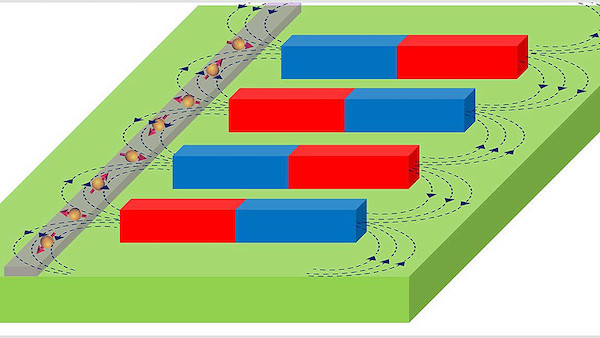 Simple-to-program nanoscale magnetic fields have applications in nanoscale magnetic resonance imaging, nanoparticle manipulation and the engineering of Majorana fermions—particles with potential in quantum computing. Hosting Majorana fermions in a material requires a nanoscale magnetic field to be in one dimension (1D) and spatially rotating. CINT scientists and collaborators have demonstrated a new method for creating this sort of magnetic field.
Simple-to-program nanoscale magnetic fields have applications in nanoscale magnetic resonance imaging, nanoparticle manipulation and the engineering of Majorana fermions—particles with potential in quantum computing. Hosting Majorana fermions in a material requires a nanoscale magnetic field to be in one dimension (1D) and spatially rotating. CINT scientists and collaborators have demonstrated a new method for creating this sort of magnetic field.
Researchers cast neural nets to simulate molecular motion
LANL News Release (07/02/19)News Wise (07/02/2019)
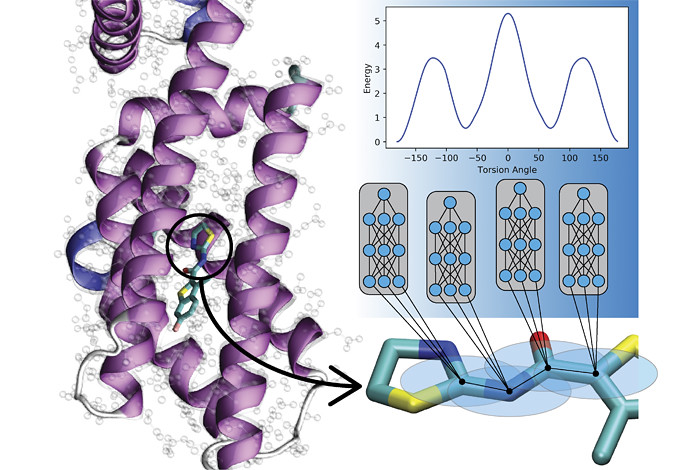 New work from CINT scientists and collaborators is showing that artificial neural nets can be trained to encode quantum mechanical laws to describe the motions of molecules, supercharging simulations potentially across a broad range of fields. The new technique promises to advance the capabilities of researchers in many fields and improve the accuracy of machine learning-based potentials in future studies of metal alloys and detonation physics.
New work from CINT scientists and collaborators is showing that artificial neural nets can be trained to encode quantum mechanical laws to describe the motions of molecules, supercharging simulations potentially across a broad range of fields. The new technique promises to advance the capabilities of researchers in many fields and improve the accuracy of machine learning-based potentials in future studies of metal alloys and detonation physics.
Detecting intersubband polaritons in a single nanoantenna
Nanowerk (06/18/19) CINT user Oleg Mitrofanov describes his latest research at CINT working with a number of CINT staff: "Our latest work demonstrates that it is possible to study polaritons in a single isolated nanoantenna. By probing evanescent fields on the nanoantenna surface, we observed a signature of polaritons formed underneath the antenna surface."
CINT user Oleg Mitrofanov describes his latest research at CINT working with a number of CINT staff: "Our latest work demonstrates that it is possible to study polaritons in a single isolated nanoantenna. By probing evanescent fields on the nanoantenna surface, we observed a signature of polaritons formed underneath the antenna surface."
Quantum information gets a boost from thin-film breakthrough
LANL News Release (05/29/19) An innovative method for controlling single-photon emission for specific locations in 2D materials may offer a new path toward all-optical quantum computers and other quantum technologies. The research exploits strain at highly spatially localized and well-separated emission sites, or tips, in a tungsten/selenium film. The team of CINT scientists and collaborators synthesized the film through chemical vapor deposition using a multi-step, diffusion-mediated gas source.
An innovative method for controlling single-photon emission for specific locations in 2D materials may offer a new path toward all-optical quantum computers and other quantum technologies. The research exploits strain at highly spatially localized and well-separated emission sites, or tips, in a tungsten/selenium film. The team of CINT scientists and collaborators synthesized the film through chemical vapor deposition using a multi-step, diffusion-mediated gas source.
Isotope composition impacts optical spectrum of 2D bilayer WSe2
MRS Bulletin (05/24/19)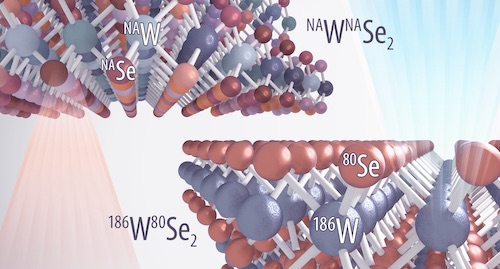 Recent work by CINT scientists and collaborators has continued to gain media attention. Their work is the first-ever demonstration of isotopic purification in a 2D TMD, showing changes in the electronic band structure as well as an unexpected change in the light emission spectra.
Recent work by CINT scientists and collaborators has continued to gain media attention. Their work is the first-ever demonstration of isotopic purification in a 2D TMD, showing changes in the electronic band structure as well as an unexpected change in the light emission spectra.
Thwarting oil-pipeline corrosion by identifying nanoscale villains
Sandia LabNews (05/23/19)Scienmag (06/06/2019)
ScienceDaily (06/06/2019)
World Industrial Reporter (06/07/2019)
Environment News Service (06/07/2019)
The Chemical Engineer (07/17/2019)
Albuquerque Journal (08/12/2019)
 Researchers at Sandia, CINT, and the Aramco Research Center in Boston have found that a particular form of nanoscale corrosion can cause variations in material longevity that unpredictably decrease the working life of steel pipes, according to a recent paper in Nature’s Materials Degradation journal.
Researchers at Sandia, CINT, and the Aramco Research Center in Boston have found that a particular form of nanoscale corrosion can cause variations in material longevity that unpredictably decrease the working life of steel pipes, according to a recent paper in Nature’s Materials Degradation journal.
Hongyou Fan wins mid-career research award
Sandia Labs News Release (04/17/19) CINT affiliate scientist Hongyou Fan is the sole recipient of this year's Mid-Career Researcher Award from the Materials Research Society, the largest materials society in the United States. The distinction is given midway in a researcher's career for exceptional achievements in materials research and for notable leadership in the field. Hongyou was chosen for "outstanding contributions in nanoparticle self-assembly of functional nanomaterials."
CINT affiliate scientist Hongyou Fan is the sole recipient of this year's Mid-Career Researcher Award from the Materials Research Society, the largest materials society in the United States. The distinction is given midway in a researcher's career for exceptional achievements in materials research and for notable leadership in the field. Hongyou was chosen for "outstanding contributions in nanoparticle self-assembly of functional nanomaterials."
At the 2D scale, isotopic composition has unforeseen effects on light emission
LANL Science Brief (04/08/19) CINT scientists and collaborators were the first to grow an isotopically pure and highly uniform TMD material only six atoms thick. They compared this to an otherwise identical film of naturally abundant TMD, which has several different isotopes within the material. Along with characterizing the electronic band structure and vibrational spectra, the team found a surprisingly large effect in light emission, which is not predicted by current theoretical models.
CINT scientists and collaborators were the first to grow an isotopically pure and highly uniform TMD material only six atoms thick. They compared this to an otherwise identical film of naturally abundant TMD, which has several different isotopes within the material. Along with characterizing the electronic band structure and vibrational spectra, the team found a surprisingly large effect in light emission, which is not predicted by current theoretical models.
Sergei Tretiak honored as Fellow of the Royal Society of Chemistry
LANL Science Brief (03/21/19)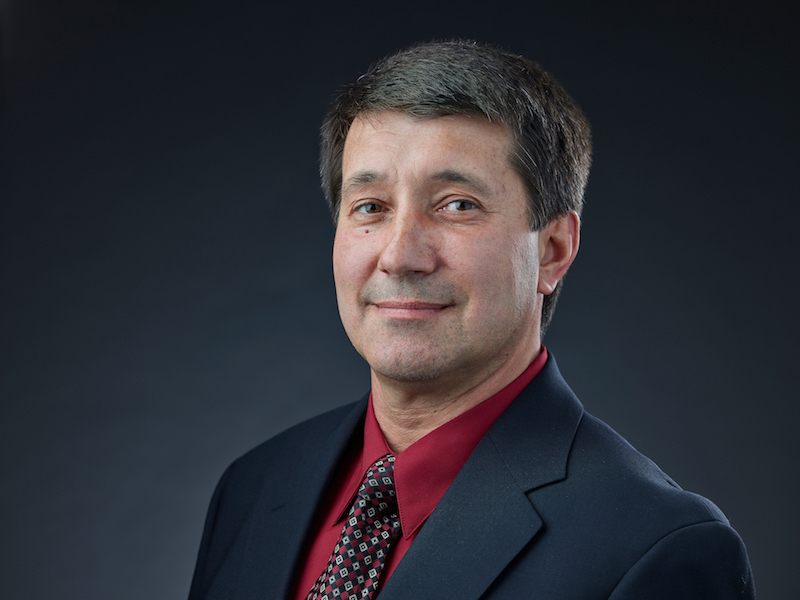 CINT scientist Sergei Tretiak is being inducted as a Fellow of the Royal Society of Chemistry (RSC).The RSC Fellows program recognizes scientists for their outstanding achievements in and contributions to chemical sciences, the profession and the Society. The lifelong designation recognizes RSC members for their excellence in scientific leadership and their impact in the field.
CINT scientist Sergei Tretiak is being inducted as a Fellow of the Royal Society of Chemistry (RSC).The RSC Fellows program recognizes scientists for their outstanding achievements in and contributions to chemical sciences, the profession and the Society. The lifelong designation recognizes RSC members for their excellence in scientific leadership and their impact in the field.
New reactor-liner alloy material offers strength, resilience
LANL News Release (03/05/19) A new tungsten-based alloy developed at Los Alamos National Laboratory, in part at CINT, can withstand unprecedented amounts of radiation without damage. Essential for extreme irradiation environments, previously explored materials have thus far been hobbled by weakness against fracture, but this new alloy seems to defeat that problem.
A new tungsten-based alloy developed at Los Alamos National Laboratory, in part at CINT, can withstand unprecedented amounts of radiation without damage. Essential for extreme irradiation environments, previously explored materials have thus far been hobbled by weakness against fracture, but this new alloy seems to defeat that problem.
Outstanding referee for Physical Review journals
American Physical Society (02/26/19)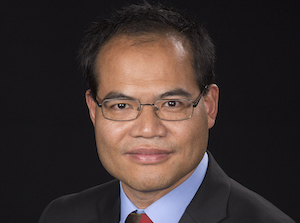 CINT scientist Jian-Xin Zhu has been selected by The American Physical Society (APS) as one of the Outstanding Referees for 2019. These referees have demonstrated exceptional work in the assessment of manuscripts published in the Physical Review journals.
CINT scientist Jian-Xin Zhu has been selected by The American Physical Society (APS) as one of the Outstanding Referees for 2019. These referees have demonstrated exceptional work in the assessment of manuscripts published in the Physical Review journals.
Scientist at Los Alamos lab earns grant from L’Oréal
Santa Fe New Mexican (02/16/19) As part of her L’Oréal fellowship, CINT postdoc Stacy Copp works as a mentor for undergraduate students and has developed classroom science programs she hopes to bring to Albuquerque Public Schools. "Scientists should be bold and decide they are going to give everybody a chance on research," she said. "It is really important that we bring a diverse set of voices to science."
As part of her L’Oréal fellowship, CINT postdoc Stacy Copp works as a mentor for undergraduate students and has developed classroom science programs she hopes to bring to Albuquerque Public Schools. "Scientists should be bold and decide they are going to give everybody a chance on research," she said. "It is really important that we bring a diverse set of voices to science."
Taking diamond qubits for a spin
BES Science Highlight (02/11/19) By implanting silicon ions in diamond with extreme precision and then controlling the strain on the crystal structure, CINT scientists and collaborators showed that they could significantly increase the spin lifetimes of solid-state quantum bits. This is of fundamental importance to quantum mechanics and quantum computing.
By implanting silicon ions in diamond with extreme precision and then controlling the strain on the crystal structure, CINT scientists and collaborators showed that they could significantly increase the spin lifetimes of solid-state quantum bits. This is of fundamental importance to quantum mechanics and quantum computing.
Controling the colors of fluorescent silver nanoparticles
Advances in Engineering (02/02/19) A team of researchers from CINT, the University at Albany – SUNY, and University of California Santa Barbara carried out an investigation on the genomic role of DNA sequence for fluorescent silver clusters using a data-driven approach. They sought to engineer DNA templates so as to control the morphology, and thereby the fluorescence color, of clusters of 10-20 silver atoms. Their work was published in ACS Nano.
A team of researchers from CINT, the University at Albany – SUNY, and University of California Santa Barbara carried out an investigation on the genomic role of DNA sequence for fluorescent silver clusters using a data-driven approach. They sought to engineer DNA templates so as to control the morphology, and thereby the fluorescence color, of clusters of 10-20 silver atoms. Their work was published in ACS Nano.
Toward ultrafast spintronics
Phys.org (01/21/19)Asian Scientist (01/22/19)
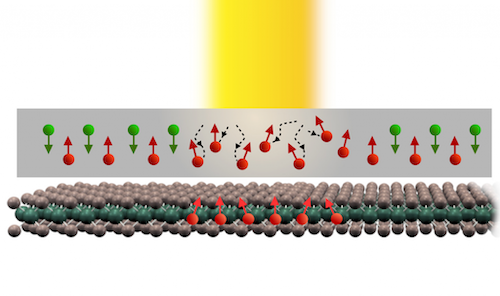 A breakthrough in the speed and efficiency of spintronics has been achieved by a team of scientists from Singapore in collaboration with CINT. They have shown that an ultrashort pulse of spin current, lasting less than a picosecond (one trillionth of a second), can be injected from a metal to a semiconductor with amazing efficiency, breaking the previous spin injection record by over 10000 times.
A breakthrough in the speed and efficiency of spintronics has been achieved by a team of scientists from Singapore in collaboration with CINT. They have shown that an ultrashort pulse of spin current, lasting less than a picosecond (one trillionth of a second), can be injected from a metal to a semiconductor with amazing efficiency, breaking the previous spin injection record by over 10000 times.
Superconductors due for a tuneup
Rice University News & Media (01/16/19)Photonics Online (01/16/19)
 A CINT user project involving theoretical physicists from Rice University and CINT demonstrates a new design principle for tuning quantum materials to achieve unconventional superconductivity at higher temperatures. The team has been investigating unusual patterns of superconductivity that have previously been reported in iron selenide. They show how nematicity, an unusual electronic order, can boost the chances that superconductivity will arise from electron-pairing in specific orbitals.
A CINT user project involving theoretical physicists from Rice University and CINT demonstrates a new design principle for tuning quantum materials to achieve unconventional superconductivity at higher temperatures. The team has been investigating unusual patterns of superconductivity that have previously been reported in iron selenide. They show how nematicity, an unusual electronic order, can boost the chances that superconductivity will arise from electron-pairing in specific orbitals.
Rich research opportunities at LANL user facilities
Los Alamos Daily Post (12/30/18)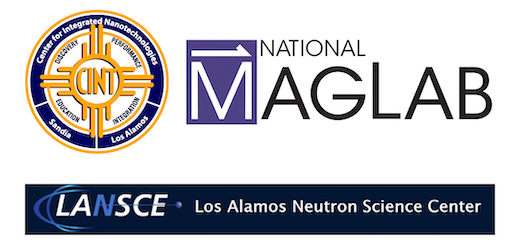 Through its technology transfer efforts, Los Alamos National Laboratory can implement user facility agreements that allow its partners and other entities to conduct research at many of its unique facilities. In 2017, LANL hosted more than 1500 users at CINT, LANSCE, and NHMFL. Users came from across the DOE complex, from national and international academia, and from industrial companies across the United States.
Through its technology transfer efforts, Los Alamos National Laboratory can implement user facility agreements that allow its partners and other entities to conduct research at many of its unique facilities. In 2017, LANL hosted more than 1500 users at CINT, LANSCE, and NHMFL. Users came from across the DOE complex, from national and international academia, and from industrial companies across the United States.
Former CINT director named Fellow of the National Academy of Inventors
University at Buffalo News Center (12/19/18) University at Buffalo scientist Quanxi Jia, a world-renowned expert in materials science and technology and former director of CINT, has been elected a Fellow of the National Academy of Inventors for demonstrating a prolific spirit of innovation in creating or facilitating outstanding inventions that have made a tangible impact on quality of life, economic development and the welfare of society.
University at Buffalo scientist Quanxi Jia, a world-renowned expert in materials science and technology and former director of CINT, has been elected a Fellow of the National Academy of Inventors for demonstrating a prolific spirit of innovation in creating or facilitating outstanding inventions that have made a tangible impact on quality of life, economic development and the welfare of society.
System monitors radiation damage to materials in real-time
MIT News (12/18/18)Materials World (01/31/19)
 A collaboration between MIT, CINT, and Sandia National Labs has resulted in a new laser-based system that can be used to observe changes to the physical properties of materials in high-radiation environments without destroying or altering them. Knowing the condition of materials inside nuclear plants can be critical to understanding whether their operation can be safely extended, and if so by how much.
A collaboration between MIT, CINT, and Sandia National Labs has resulted in a new laser-based system that can be used to observe changes to the physical properties of materials in high-radiation environments without destroying or altering them. Knowing the condition of materials inside nuclear plants can be critical to understanding whether their operation can be safely extended, and if so by how much.
Quantum research gets a boost at CINT
Sandia Labs News Release (10/24/18)San Francisco Chronicle (10/24/18)
Washington Times (10/25/18)
Albuquerque Journal (12/10/18)
 The Department of Energy has awarded Sandia and Los Alamos national laboratories $8 million for quantum research — the study of the fundamental physics of all matter — at CINT. The award will fund two three-year projects enabling scientists at the two labs to build advanced tools for nanotechnology research and development. Because of the collaborative nature of CINT, the awards also will provide opportunities for researchers outside the labs to benefit from the new technologies.
The Department of Energy has awarded Sandia and Los Alamos national laboratories $8 million for quantum research — the study of the fundamental physics of all matter — at CINT. The award will fund two three-year projects enabling scientists at the two labs to build advanced tools for nanotechnology research and development. Because of the collaborative nature of CINT, the awards also will provide opportunities for researchers outside the labs to benefit from the new technologies.
Research scientist focuses on mentoring students
Albuquerque Journal (10/21/18)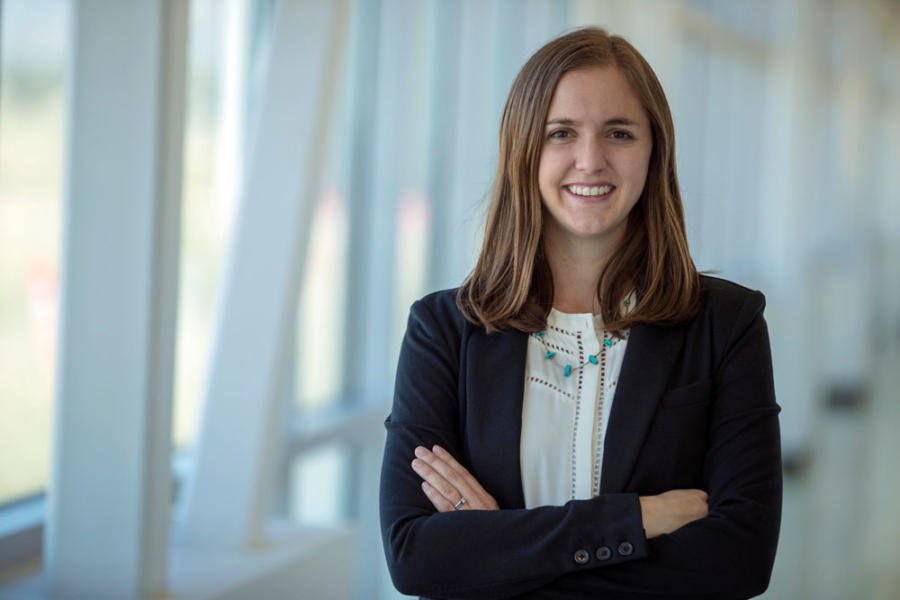 CINT postdoc Stacy Copp was recently awarded a L’Oréal USA For Women in Science Fellowship. It was the guidance of professors and mentoring from older students, Copp said, that helped usher her into her current career as a research scientist. The 29 year old Albuquerque native and La Cueva High graduate now tries to do the same for students in her field.
CINT postdoc Stacy Copp was recently awarded a L’Oréal USA For Women in Science Fellowship. It was the guidance of professors and mentoring from older students, Copp said, that helped usher her into her current career as a research scientist. The 29 year old Albuquerque native and La Cueva High graduate now tries to do the same for students in her field.
Sergei Tretiak honored as LANL Laboratory Fellow
LANL News Release (10/16/18) CINT scientist Sergei Tretiak was honored as a LANL Laboratory Fellow. "To be named a Fellow is one of the Laboratory’s highest honors," said Terry C. Wallace, Jr., Los Alamos National Laboratory director. The overarching theme of Sergei's research is to develop a theoretical framework for electronic properties in complex molecular structures. These materials are at the center of current scientific research, with potential applications in photonics, displays, and sunlight harvesting, such as photovoltaic devices based on organic and organic–inorganic active materials.
CINT scientist Sergei Tretiak was honored as a LANL Laboratory Fellow. "To be named a Fellow is one of the Laboratory’s highest honors," said Terry C. Wallace, Jr., Los Alamos National Laboratory director. The overarching theme of Sergei's research is to develop a theoretical framework for electronic properties in complex molecular structures. These materials are at the center of current scientific research, with potential applications in photonics, displays, and sunlight harvesting, such as photovoltaic devices based on organic and organic–inorganic active materials.
Nobel Laureate underscores CINT annual meeting
Sandia LabNews (10/11/18)
Jennifer Hollingsworth honored with APS fellowship
LANL News Release (10/11/18) CINT scientist Jennifer Hollingsworth was selected as a 2018 APS Fellow. The APS Fellowship Program recognizes members who have made significant advances in physics through original research and publications, or made significant contributions in the applications of physics to science and technology. Jen was cited for the discovery and development of non-blinking giant quantum dots, spanning pioneering contributions to materials chemistry, the photophysics of excited-state processes in nanomaterials, and applications in optoelectronics.
CINT scientist Jennifer Hollingsworth was selected as a 2018 APS Fellow. The APS Fellowship Program recognizes members who have made significant advances in physics through original research and publications, or made significant contributions in the applications of physics to science and technology. Jen was cited for the discovery and development of non-blinking giant quantum dots, spanning pioneering contributions to materials chemistry, the photophysics of excited-state processes in nanomaterials, and applications in optoelectronics.
Mercedes Taylor named as one of first Jill Hruby Fellows
Sandia Labs News Release (10/11/18) Sandia National Labs has named Mercedes Taylor as one of its first Jill Hruby Fellows. The honorees have each been awarded a three-year postdoctoral fellowship in technical leadership, comprising national security-relevant research with an executive mentor. The Jill Hruby Fellowship is meant to encourage women to consider leadership in national security science and engineering. Over the next three years, Mercedes' research will aim to develop new porous plastics that purify water by soaking up ions — electrically charged atoms and molecules — with an emphasis on negatively charged ions, called anions. She will work under the mentorship of CINT scientist Dale Huber.
Sandia National Labs has named Mercedes Taylor as one of its first Jill Hruby Fellows. The honorees have each been awarded a three-year postdoctoral fellowship in technical leadership, comprising national security-relevant research with an executive mentor. The Jill Hruby Fellowship is meant to encourage women to consider leadership in national security science and engineering. Over the next three years, Mercedes' research will aim to develop new porous plastics that purify water by soaking up ions — electrically charged atoms and molecules — with an emphasis on negatively charged ions, called anions. She will work under the mentorship of CINT scientist Dale Huber.
L'Oréal For Women in Science Fellowship awarded to Stacy Copp
L'Oréal Press Release (09/25/18) L’Oréal USA has announced the recipients of the 2018 For Women in Science Fellowship, which annually awards five female postdoctoral scientists grants of $60,000 each to advance their research. One of this year's recipients is CINT postdoc Stacy Copp, whose research in soft matter physics at Los Alamos National Laboratory focuses on developing new materials that produce and manipulate light, with potential applications in biomedical diagnostics, solar energy, and energy-efficient lighting.
L’Oréal USA has announced the recipients of the 2018 For Women in Science Fellowship, which annually awards five female postdoctoral scientists grants of $60,000 each to advance their research. One of this year's recipients is CINT postdoc Stacy Copp, whose research in soft matter physics at Los Alamos National Laboratory focuses on developing new materials that produce and manipulate light, with potential applications in biomedical diagnostics, solar energy, and energy-efficient lighting.
Thomas O'Connor awarded Sandia's Truman Fellowship
Sandia Lab News (09/14/18)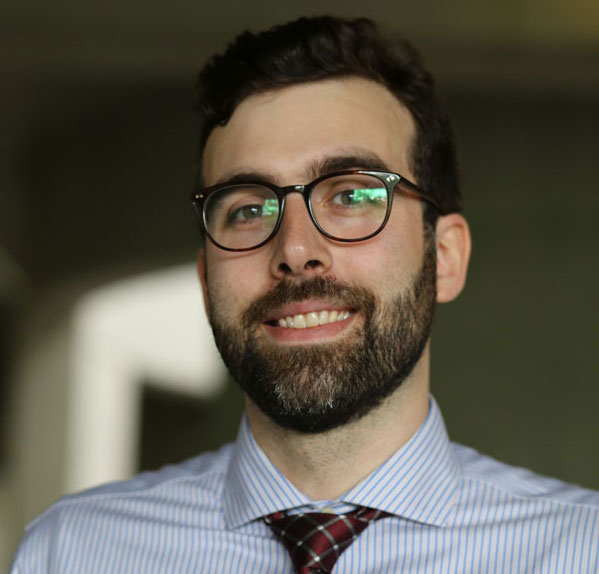 CINT welcomes a new postdoc, Thomas O’Connor, who has been awarded Sandia’s prestigious Truman Fellowship. Candidates for this fellowship must propose bold, cutting-edge research and must earn the endorsement of a selection committee of senior scientists, their future peers, and Sandia’s Chief Research Officer. His research is focused on using molecular and continuum simulations to model the flow of polymers during additive manufacturing. Thomas will work with CINT scientists Mark Stevens, Gary Grest, and Ryan Wixom.
CINT welcomes a new postdoc, Thomas O’Connor, who has been awarded Sandia’s prestigious Truman Fellowship. Candidates for this fellowship must propose bold, cutting-edge research and must earn the endorsement of a selection committee of senior scientists, their future peers, and Sandia’s Chief Research Officer. His research is focused on using molecular and continuum simulations to model the flow of polymers during additive manufacturing. Thomas will work with CINT scientists Mark Stevens, Gary Grest, and Ryan Wixom.
Chemical selection of emission state configuration in a quantum-light emitter
LANL Science Brief (09/06/18) CINT researchers and their collaborators have found a new way to control quantum-light emitters using so-called zigzag nanotube structures. Their work is published in the latest edition of Nature Chemistry. Stephen Doorn said, "Our effort at LANL has been advancing the development of chemically controlled defects in carbon nanotubes as room-temperature single photon emitters. These are of significant interest for enabling new optical approaches to quantum information processing. Our latest work aims to address how to control and narrow the emission wavelength range through control of functionalization chemistry."
CINT researchers and their collaborators have found a new way to control quantum-light emitters using so-called zigzag nanotube structures. Their work is published in the latest edition of Nature Chemistry. Stephen Doorn said, "Our effort at LANL has been advancing the development of chemically controlled defects in carbon nanotubes as room-temperature single photon emitters. These are of significant interest for enabling new optical approaches to quantum information processing. Our latest work aims to address how to control and narrow the emission wavelength range through control of functionalization chemistry."
Tuning terahertz beams with nanoparticles
BES Science Highlight (09/05/18) CINT scientists and their collaborators have uncovered a way to control terahertz radiation using tiny engineered particles in a magnetic field. By controlling the strength and direction of the applied magnetic field, the nanoparticles dynamically tuned a terahertz beam’s phase and amplitude. This research potentially opens the doors for better medical and environmental sensors.
CINT scientists and their collaborators have uncovered a way to control terahertz radiation using tiny engineered particles in a magnetic field. By controlling the strength and direction of the applied magnetic field, the nanoparticles dynamically tuned a terahertz beam’s phase and amplitude. This research potentially opens the doors for better medical and environmental sensors.
Carbon nanotubes give two excitons for the price of one
BES Science Highlight (09/05/18)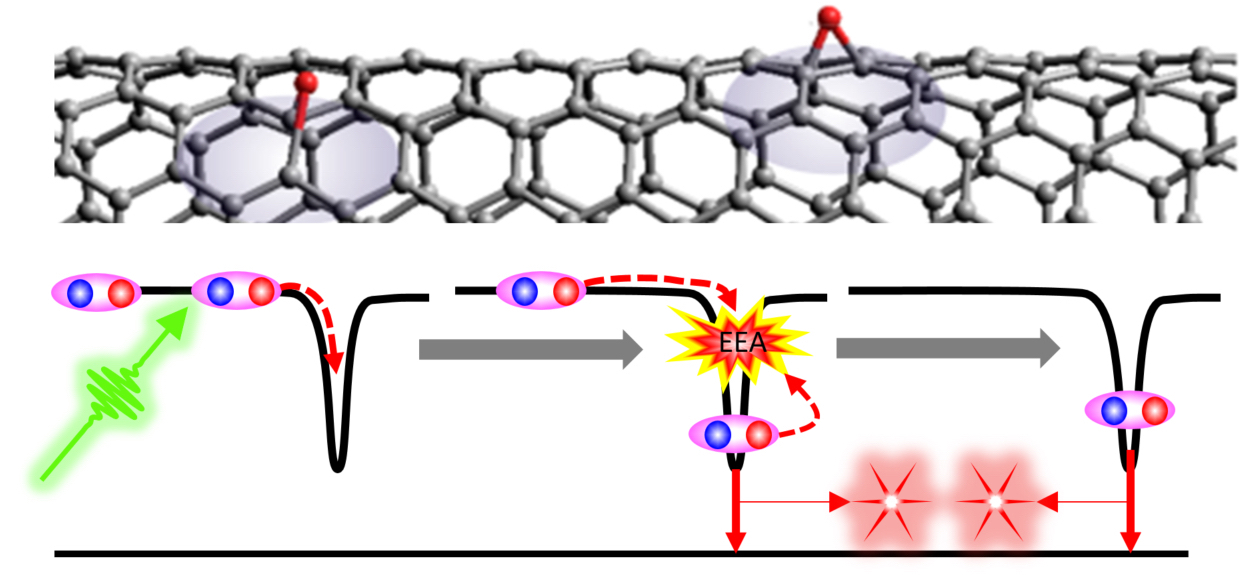 CINT scientists have identified how modified carbon nanotubes emit photon pairs. The experiments and theory show that the photon pairs are the result of the capture and recombination of two excitons (electron–hole pairs). This efficient generation of photon pairs from modified carbon nanotubes shows a path to new types of light sources.
CINT scientists have identified how modified carbon nanotubes emit photon pairs. The experiments and theory show that the photon pairs are the result of the capture and recombination of two excitons (electron–hole pairs). This efficient generation of photon pairs from modified carbon nanotubes shows a path to new types of light sources.
Progress toward plugging an antibiotic pump
Sandia Labs News Release (08/03/18)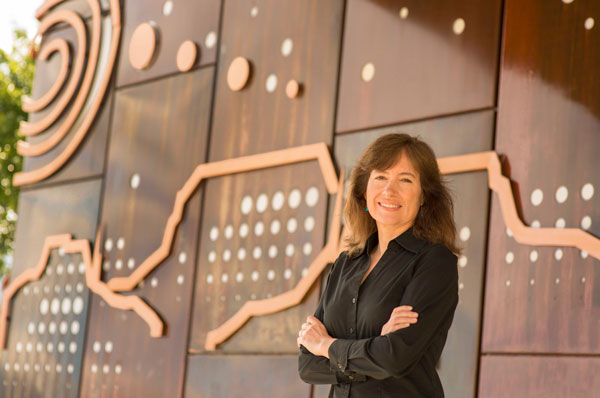 Each year in the U.S., at least 23,000 people die from infections caused by antibiotic-resistant bacteria. One way bacteria develop resistance to many different antibiotics is by producing pumps that spit out unfamiliar small molecules, such as antibiotics, before they can do any damage. The researchers teased out the details of how one antibiotic pump works. This project made extensive use of Sandia’s high-performance computing resources and was conducted at CINT.
Each year in the U.S., at least 23,000 people die from infections caused by antibiotic-resistant bacteria. One way bacteria develop resistance to many different antibiotics is by producing pumps that spit out unfamiliar small molecules, such as antibiotics, before they can do any damage. The researchers teased out the details of how one antibiotic pump works. This project made extensive use of Sandia’s high-performance computing resources and was conducted at CINT.
Large supercrystals promise superior sensors
Sandia Labs News Release (08/01/18) Using an artful combination of nanotechnology and basic chemistry, Sandia National Laboratories researchers, including CINT affiliate scientist Hongyou Fan, have encouraged gold nanoparticles to self-assemble into unusually large supercrystals that could significantly improve the detection sensitivity for chemicals in explosives or drugs.
Using an artful combination of nanotechnology and basic chemistry, Sandia National Laboratories researchers, including CINT affiliate scientist Hongyou Fan, have encouraged gold nanoparticles to self-assemble into unusually large supercrystals that could significantly improve the detection sensitivity for chemicals in explosives or drugs.
CINT scientsts to be part of 2018 DOE Energy Frontier Research Center
LANL News Release (07/24/18)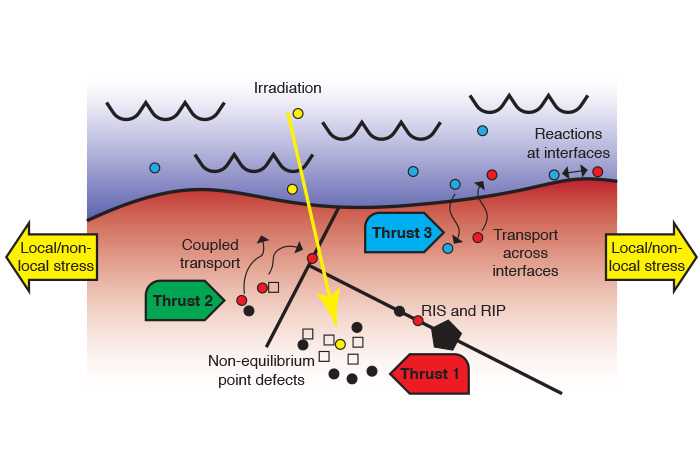 CINT scientist Nan Li and CINT affiliate scientist Yongqiang Wang are part of the LANL team that was recently awarded EFRC funding. The new center, called FUTURE (Fundamental Understanding of Transport Under Reactor Extremes), will explore the coupling of radiation damage and corrosion in order to predict irradiation-assisted corrosion in passivating and non-passivating environments for materials in nuclear energy systems.
CINT scientist Nan Li and CINT affiliate scientist Yongqiang Wang are part of the LANL team that was recently awarded EFRC funding. The new center, called FUTURE (Fundamental Understanding of Transport Under Reactor Extremes), will explore the coupling of radiation damage and corrosion in order to predict irradiation-assisted corrosion in passivating and non-passivating environments for materials in nuclear energy systems.
Yuxiang Chen wins "Most Fundable Technology" award at DisrupTech
LANL Community Connections (08/01/18)LANL News Release (07/24/18)
 CINT postdoc Yuxiang Chen was recognized for his outstanding presentation at the 2018 DisrupTech, an event that showcases technologies with the potential to “disrupt” existing markets or even to create new ones. Yuxiang won the “Most Fundable Technology” award for his presentation “NanoCluster Beacons: Fast Testing for Food Safety.” The $25,000 funding award will help him improve his technology that quickly and accurately tests pathogens in food.
CINT postdoc Yuxiang Chen was recognized for his outstanding presentation at the 2018 DisrupTech, an event that showcases technologies with the potential to “disrupt” existing markets or even to create new ones. Yuxiang won the “Most Fundable Technology” award for his presentation “NanoCluster Beacons: Fast Testing for Food Safety.” The $25,000 funding award will help him improve his technology that quickly and accurately tests pathogens in food.
Shining light on excited-state dynamics in perovskite materials
LANL Science Brief (07/17/18) Hybrid organic-inorganic perovskites are materials with attractive optoelectronic properties including exceptional solar cell performance. In this latest research published in Nature Communications, CINT scientist Sergei Tretiak and collaborators show that polaron formation via nuclear dynamics in perovskite may be important for efficient charge separation and collection.
Hybrid organic-inorganic perovskites are materials with attractive optoelectronic properties including exceptional solar cell performance. In this latest research published in Nature Communications, CINT scientist Sergei Tretiak and collaborators show that polaron formation via nuclear dynamics in perovskite may be important for efficient charge separation and collection.
Coherent exciton-vibrational dynamics and energy transfer in conjugated organics
LANL Science Brief (07/03/18)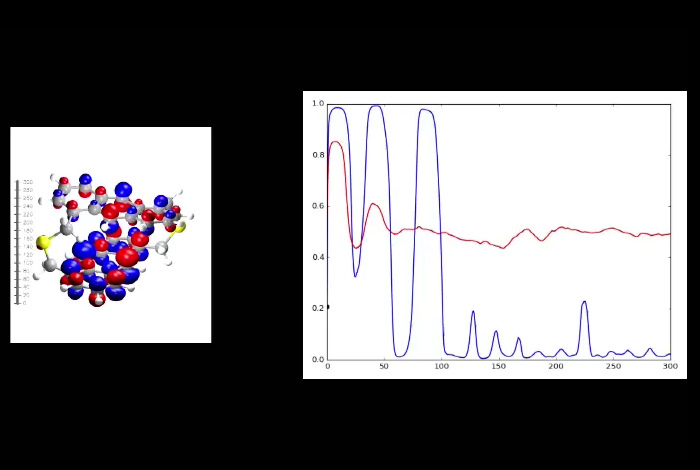 In a new theoretical study described in a Nature Communications paper, CINT scientist Sergei Tretiak and collaborators demonstrate the appearance of coherent electron-vibrational dynamics after so-called non-radiative relaxation. The effect appears as a ‘sloshing’ of electron density back and forth between molecular sites.
In a new theoretical study described in a Nature Communications paper, CINT scientist Sergei Tretiak and collaborators demonstrate the appearance of coherent electron-vibrational dynamics after so-called non-radiative relaxation. The effect appears as a ‘sloshing’ of electron density back and forth between molecular sites.
Light mixer generates 11 colors simultaneously
Sandia Labs News Release (06/28/18) Research by CINT scientists Igal Brener and John Reno and their collaborators shows how a metamaterial made up of an array of nanocylinders mixes two laser pulses of near infrared light to produce 11 waves of light. The light ranges in color from the near infrared, through the colors of the rainbow, to ultraviolet. This work was published in Nature Communications. Igal says, "Without CINT's specialized femtosecond laser system, it would have been very challenging to perform these measurements."
Research by CINT scientists Igal Brener and John Reno and their collaborators shows how a metamaterial made up of an array of nanocylinders mixes two laser pulses of near infrared light to produce 11 waves of light. The light ranges in color from the near infrared, through the colors of the rainbow, to ultraviolet. This work was published in Nature Communications. Igal says, "Without CINT's specialized femtosecond laser system, it would have been very challenging to perform these measurements."
Carbon nanotube optics poised to provide pathway to optical-based quantum cryptography and quantum computing
LANL News Release (06/18/18) Researchers at CINT and partners in France and Germany are exploring the enhanced potential of carbon nanotubes as single-photon emitters for quantum information processing. In describing their work published in Nature Materials, CINT scientist Steve Doorn says, "In addition to defining the state of the art, we wanted to highlight where the challenges are for future progress and lay out some of what may be the most promising future directions for moving forward in this area. Ultimately, we hope to draw more researchers into this field."
Researchers at CINT and partners in France and Germany are exploring the enhanced potential of carbon nanotubes as single-photon emitters for quantum information processing. In describing their work published in Nature Materials, CINT scientist Steve Doorn says, "In addition to defining the state of the art, we wanted to highlight where the challenges are for future progress and lay out some of what may be the most promising future directions for moving forward in this area. Ultimately, we hope to draw more researchers into this field."
A bit of quantum logic
BES Science Highlight (06/18/18) Quantum computers could tackle problems that current supercomputers can’t. Quantum computers rely on quantum bits, or "qubits," which represent data by the binary state of electron spins. Two systems existed to create qubits—donor atoms and quantum dots. CINT researchers and collaborators have successfully integrated the systems. This hybrid approach, which has remained elusive until now, exploits the advantages of the two qubit systems.
Quantum computers could tackle problems that current supercomputers can’t. Quantum computers rely on quantum bits, or "qubits," which represent data by the binary state of electron spins. Two systems existed to create qubits—donor atoms and quantum dots. CINT researchers and collaborators have successfully integrated the systems. This hybrid approach, which has remained elusive until now, exploits the advantages of the two qubit systems.
Tackling a global challenge in Boston
Saudi Aramco News (06/13/18)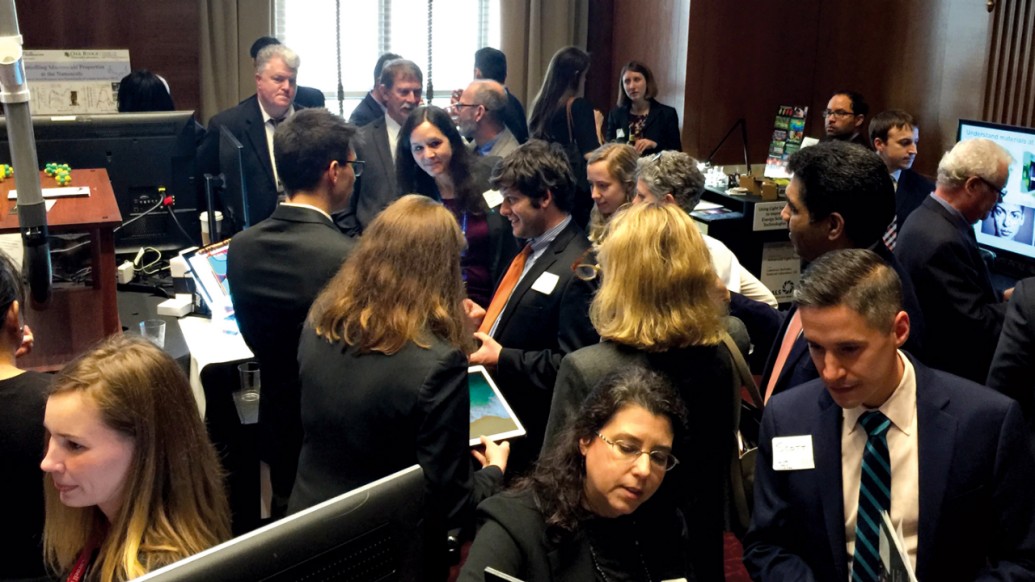 Corrosion is a global problem that costs the world $2.5 trillion annually. This chemical process is most often seen on metal surfaces as rust and can result in catastrophic failure of infrastructure, such as bridges. Researchers at the Aramco Research Center-Boston have teamed up with scientists at CINT to investigate the nanoscale mechanisms responsible for corrosion initiation and progression in steel.
Corrosion is a global problem that costs the world $2.5 trillion annually. This chemical process is most often seen on metal surfaces as rust and can result in catastrophic failure of infrastructure, such as bridges. Researchers at the Aramco Research Center-Boston have teamed up with scientists at CINT to investigate the nanoscale mechanisms responsible for corrosion initiation and progression in steel.
Automation helps speed up materials science data collection
Sandia Labs News Release (06/11/18)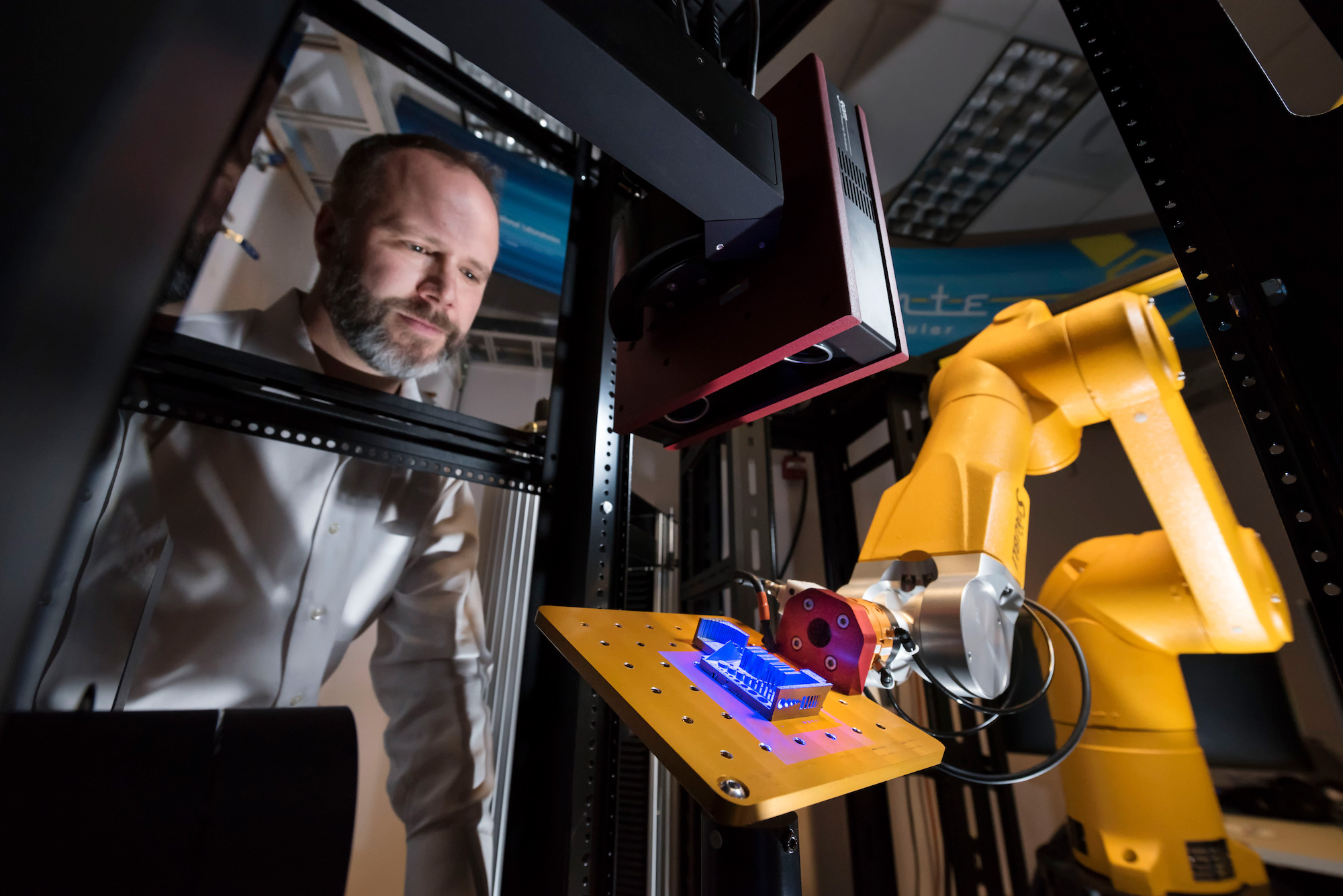 CINT scientist Brad Boyce is part of a research team at Sandia National Labs that has built a robotic cell for testing 3D-printed parts. They system conducts high-throughput testing to quickly determine the performance and properties of the parts. Brad hopes to use it for rapid materials discovery and for foundational advances in alloy performance and reliability.
CINT scientist Brad Boyce is part of a research team at Sandia National Labs that has built a robotic cell for testing 3D-printed parts. They system conducts high-throughput testing to quickly determine the performance and properties of the parts. Brad hopes to use it for rapid materials discovery and for foundational advances in alloy performance and reliability.
Constructing a unique laser application for research
Los Alamos Monitor (05/07/18)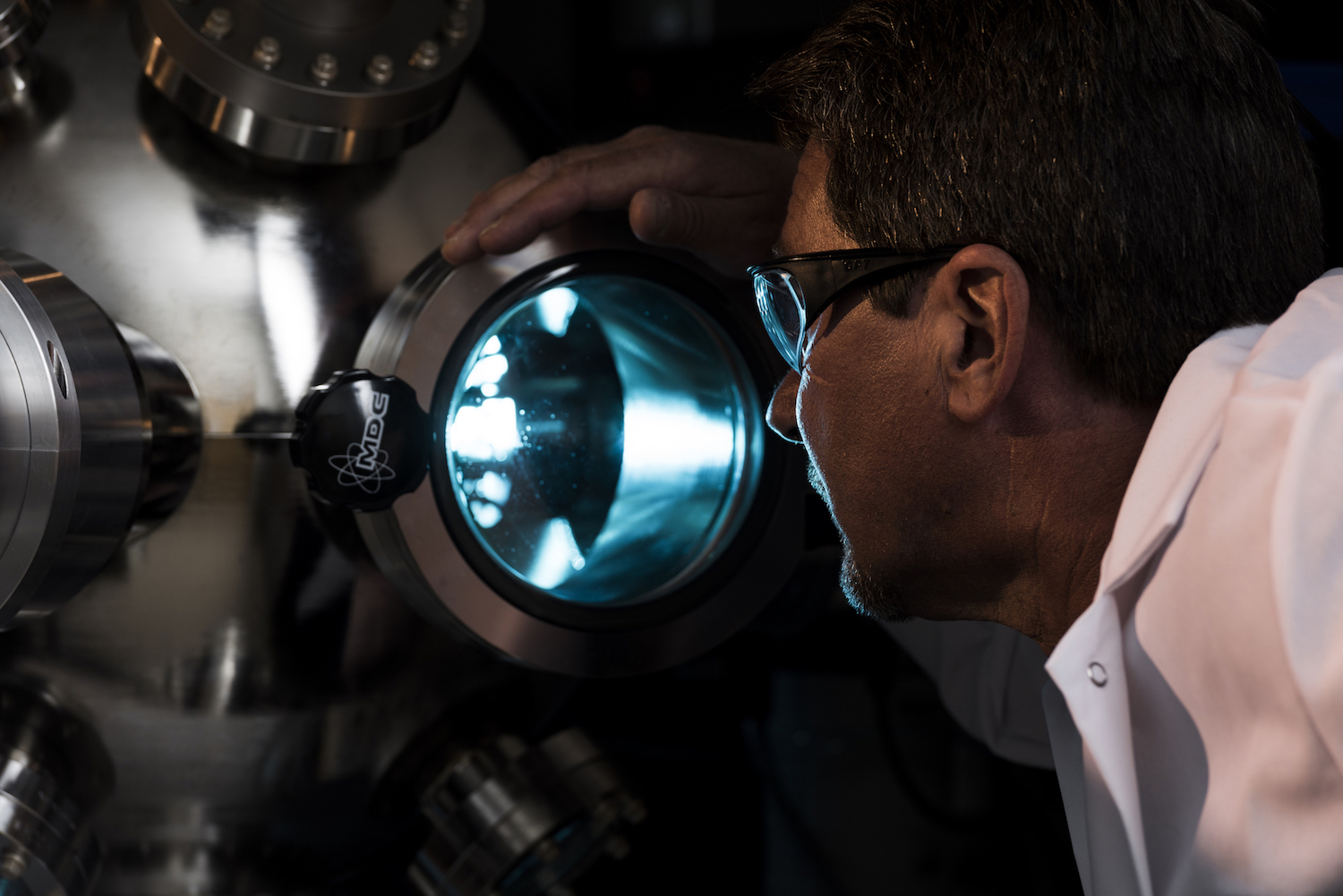 Technologist Paul Dowden oversees all pulsed laser deposition operations at CINT's Gateway Facility. This versatile system allows researchers to grow thin films ranging from tens of nanometers to micrometers in thickness. It is ultra-customizable, using multiple targets, different gases, unique wavelengths, specific configurations and offering a variety of laser parameters.
Technologist Paul Dowden oversees all pulsed laser deposition operations at CINT's Gateway Facility. This versatile system allows researchers to grow thin films ranging from tens of nanometers to micrometers in thickness. It is ultra-customizable, using multiple targets, different gases, unique wavelengths, specific configurations and offering a variety of laser parameters.
Magnetic nanoparticles leap from lab bench to breast cancer clinical trials
Sandia Labs News Release (04/30/18) CINT scientist Dale Huber has been working on the challenge of making iron-based nanoparticles the exact same size for 15 years. Now, he and his long-term collaborators at Imagion Biosystems will use these magnetic nanoparticles for their first breast cancer clinical trial later this year. The nanoparticles stick to breast cancer cells, allowing the detection and removal of even small metastases. (More on KOB 4 News).
CINT scientist Dale Huber has been working on the challenge of making iron-based nanoparticles the exact same size for 15 years. Now, he and his long-term collaborators at Imagion Biosystems will use these magnetic nanoparticles for their first breast cancer clinical trial later this year. The nanoparticles stick to breast cancer cells, allowing the detection and removal of even small metastases. (More on KOB 4 News).
CINT collaboration wins FLC's Excellence in Technology Transfer Award
Sandia Labs News Release (04/25/18) A collaboration between CINT, Sandia National Laboratories, and IR Dynamics has received one of the FLC's Excellence in Technology Transfer Awards for 2018. The project "is developing advanced nanoparticle films that boost the energy efficiency of windows, which could save American consumers as much as $12 billion each year and significantly reduce national energy consumption."
A collaboration between CINT, Sandia National Laboratories, and IR Dynamics has received one of the FLC's Excellence in Technology Transfer Awards for 2018. The project "is developing advanced nanoparticle films that boost the energy efficiency of windows, which could save American consumers as much as $12 billion each year and significantly reduce national energy consumption."
Prospecting for Gold at the Nanoscale
New Scientist (04/03/18) A team at CINT has developed a process for extracting gold from surfaces such as SIM cards. The process, which induces cavitation on the surface of SIM cards, is cheap and has practically no environmental impact. The research was recently published in the journal Small. You can also read about this research at IFLScience and ABC News.
A team at CINT has developed a process for extracting gold from surfaces such as SIM cards. The process, which induces cavitation on the surface of SIM cards, is cheap and has practically no environmental impact. The research was recently published in the journal Small. You can also read about this research at IFLScience and ABC News.
Fun with Light and Matter
1663 (03/01/18) The Los Alamos Science and Technology Magazine 1663 featured CINT scientist Hou-Tong Chen. The article describes Hou-Tong's work with "metamaterial "atoms" [which] absorb and re-radiate light like real atoms, allowing unique capabilities for imaging and communications."
The Los Alamos Science and Technology Magazine 1663 featured CINT scientist Hou-Tong Chen. The article describes Hou-Tong's work with "metamaterial "atoms" [which] absorb and re-radiate light like real atoms, allowing unique capabilities for imaging and communications."




